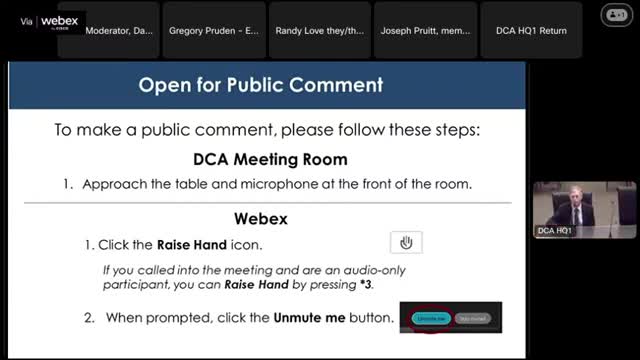California Optometrists advocate for radiofrequency technology to treat dry eye disease
February 15, 2025 | Respiratory Care Board of California, Boards and Commissions, Executive, California
This article was created by AI summarizing key points discussed. AI makes mistakes, so for full details and context, please refer to the video of the full meeting. Please report any errors so we can fix them. Report an error »

In a pivotal meeting held on February 14, 2025, the California State Board of Optometry gathered to discuss the potential inclusion of radiofrequency (RF) technology in the optometric practice for treating dry eye disease. The atmosphere was charged with anticipation as optometrists, healthcare professionals, and advocates voiced their support for this noninvasive treatment option, which many believe could significantly enhance patient care across the state.
The meeting featured a series of passionate testimonies from various stakeholders, including practicing optometrists and representatives from the California Optometric Association. They emphasized the safety and efficacy of RF technology, which utilizes controlled heat to treat conditions like meibomian gland dysfunction—a leading cause of dry eye. "RF is a very simple procedure," stated one optometrist from Rio Linda, highlighting its noninvasive nature and likening it to the application of a warm compress.
Supporters argued that allowing optometrists to use RF technology would not only improve access to care, especially in underserved areas, but also reduce healthcare costs by enabling timely treatment without unnecessary referrals to ophthalmologists. "Optometrists are often the primary providers of eye care," noted Elizabeth Hoppe, Dean of the College of Optometry at Western University of Health Sciences, reinforcing the idea that this change would streamline patient access to effective treatments.
However, the discussion was not without contention. Some voices raised concerns about the definition of surgery under California law, arguing that RF technology, which alters tissue, could fall under surgical procedures. This perspective was articulated by Dr. Michael Kouras, an ophthalmologist, who cautioned that the board's authority to approve such technologies might be limited by existing regulations.
Despite the opposition, the overwhelming sentiment from the majority of speakers was one of optimism. Many highlighted that RF technology has been successfully utilized in other states and by various healthcare professionals, including aestheticians, without adverse effects. "This is a safe, nonsurgical procedure that would be beneficial to many of our dry eye patients," stated Marcia Vincent, president of the optometrist affiliate at the United Nurses Association of California.
As the meeting drew to a close, the board expressed gratitude for the robust participation and the wealth of information shared. The discussions underscored a critical moment for optometry in California, as the potential approval of RF technology could reshape the landscape of eye care, providing new avenues for treatment and improving the quality of life for countless patients suffering from dry eye disease. The board's decision on this matter will be closely watched, as it holds significant implications for the future of optometric practice in the state.
The meeting featured a series of passionate testimonies from various stakeholders, including practicing optometrists and representatives from the California Optometric Association. They emphasized the safety and efficacy of RF technology, which utilizes controlled heat to treat conditions like meibomian gland dysfunction—a leading cause of dry eye. "RF is a very simple procedure," stated one optometrist from Rio Linda, highlighting its noninvasive nature and likening it to the application of a warm compress.
Supporters argued that allowing optometrists to use RF technology would not only improve access to care, especially in underserved areas, but also reduce healthcare costs by enabling timely treatment without unnecessary referrals to ophthalmologists. "Optometrists are often the primary providers of eye care," noted Elizabeth Hoppe, Dean of the College of Optometry at Western University of Health Sciences, reinforcing the idea that this change would streamline patient access to effective treatments.
However, the discussion was not without contention. Some voices raised concerns about the definition of surgery under California law, arguing that RF technology, which alters tissue, could fall under surgical procedures. This perspective was articulated by Dr. Michael Kouras, an ophthalmologist, who cautioned that the board's authority to approve such technologies might be limited by existing regulations.
Despite the opposition, the overwhelming sentiment from the majority of speakers was one of optimism. Many highlighted that RF technology has been successfully utilized in other states and by various healthcare professionals, including aestheticians, without adverse effects. "This is a safe, nonsurgical procedure that would be beneficial to many of our dry eye patients," stated Marcia Vincent, president of the optometrist affiliate at the United Nurses Association of California.
As the meeting drew to a close, the board expressed gratitude for the robust participation and the wealth of information shared. The discussions underscored a critical moment for optometry in California, as the potential approval of RF technology could reshape the landscape of eye care, providing new avenues for treatment and improving the quality of life for countless patients suffering from dry eye disease. The board's decision on this matter will be closely watched, as it holds significant implications for the future of optometric practice in the state.
View full meeting
This article is based on a recent meeting—watch the full video and explore the complete transcript for deeper insights into the discussion.
View full meeting
